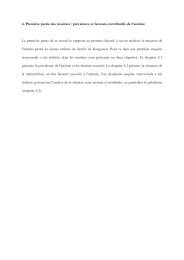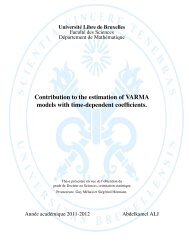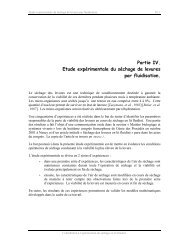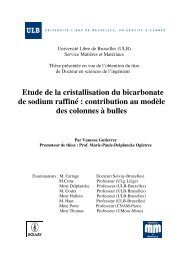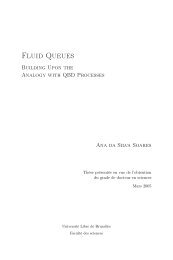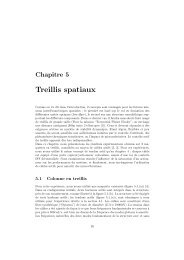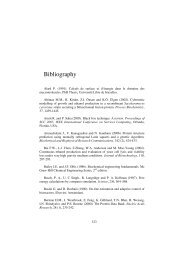Diapositive 1 - de l'Université libre de Bruxelles
Diapositive 1 - de l'Université libre de Bruxelles
Diapositive 1 - de l'Université libre de Bruxelles
You also want an ePaper? Increase the reach of your titles
YUMPU automatically turns print PDFs into web optimized ePapers that Google loves.
Chapitre IIMinor change of salinity (3 psu) caused no significant variations of the skeletal Mg/Caratio of aquarium raised P. lividus. On the contrary, Pilkey & Hower (1960) observed thatthe MgCO 3 content of field collected sand dollars is directly related to water salinity overa range of 10 psu, and Borremans et al (2009) showed a similar effect over the samerange of experimental conditions for a starfish. This is reminiscent of results obtained inForaminifera (Nürnberg et al 1996), where Mg/Ca ratios of aquarium grown individualswere only affected by drastic salinity changes (>10 psu). Borremans et al (2009) proposedthat the positive relation between Mg/Ca ratio and salinity is due to the upregulation ofcalcium concentrations in inner fluids un<strong>de</strong>r salinity <strong>de</strong>crease while magnesium is notregulated and its inner concentration <strong>de</strong>creases with salinity. We suggest this upregulationis too small to be <strong>de</strong>tected when salinity changes are low.Little is known about skeletal element incorporation pathways and skeletal elementsources in echino<strong>de</strong>rms. Potential sources of calcium and magnesium are seawater andfood. However, P. lividus food is floo<strong>de</strong>d with seawater and very probably mostmagnesium and calcium are taken up from seawater whatever the absorption route(integument or digestive tract). Nakano et al (1963) and Lewis et al (1990) showed withradioactive calcium that skeletal calcium of the echino<strong>de</strong>rm skeleton <strong>de</strong>rives fromseawater calcium. Magnesium has probably the same origin. Mg/Ca ratio is much higherin seawater (Mg/Ca SW = 5.2 mol/mol) and echino<strong>de</strong>rm coelomic fluid (Mg/Ca Coelomic fluid= 4.8 mol/mol) than in echino<strong>de</strong>rm skeleton (Mg/Ca Sk = 0.1 mol/mol). Therefore, strongpartition mechanisms of this element probably occur during magnesium incorporation inthe mineralization vacuole or the growing mineral. As calcium <strong>de</strong>livery to this vacuole ismediated by transport systems (see Dubois & Chen 1989), one may hypothesize eitherthat these systems discriminate against magnesium or that specific magnesium transportsystems eliminate this ion from the mineralizing solution (see Bentov & Erez 2006).Sr/Ca ratio. The skeletal Sr/Ca ratio of juveniles Paracentrotus lividus grown inaquarium increased with growth rate and temperature (until 19 °C). Sr/Ca variations werecorrelated with growth rate variations and the highest Sr/Ca observed in this studycorresponds to the range of optimal temperatures of somatic growth (18 °C to 22 °C)experimentally <strong>de</strong>termined by Le Gall et al (1990). These relations between Sr/Ca,growth rate and temperature are usual in biogenic calcites (e.g. De Deckker et al 1999,Lea et al 1999, Stoll et al 2002, Lorrain et al 2005) and are attributed to a predominant58



